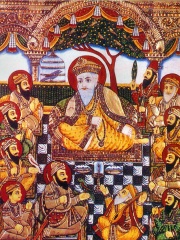
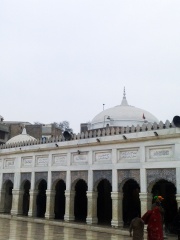
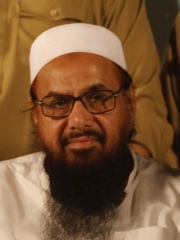

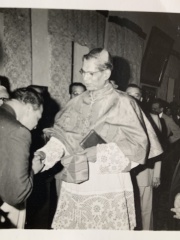
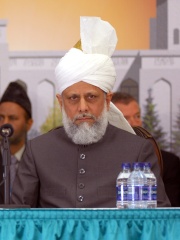
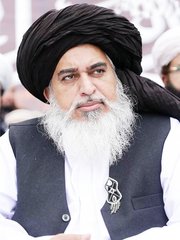
The Most Famous
RELIGIOUS FIGURES from Pakistan
This page contains a list of the greatest Pakistani Religious Figures. The pantheon dataset contains 3,187 Religious Figures, 7 of which were born in Pakistan. This makes Pakistan the birth place of the 47th most number of Religious Figures behind Belarus, and Algeria.
Top 8
The following people are considered by Pantheon to be the most legendary Pakistani Religious Figures of all time. This list of famous Pakistani Religious Figures is sorted by HPI (Historical Popularity Index), a metric that aggregates information on a biography's online popularity.

1. Guru Nanak (1469 - 1539)
With an HPI of 85.46, Guru Nanak is the most famous Pakistani Religious Figure. His biography has been translated into 94 different languages on wikipedia.
Gurū Nānak (15 April 1469 – 22 September 1539; Gurmukhi: ਗੁਰੂ ਨਾਨਕ; pronunciation: [gʊɾuː naːɳəkᵊ], ), also known as Bābā Nānak ('Father Nanak'), was an Indian spiritual teacher, mystic and poet, who is regarded as the founder of Sikhism and is the first of the ten Sikh Gurus. Nanak is said to have travelled far and wide across Asia teaching people the message of Ik Onkar (ੴ, 'One God'), who dwells in every one of his creations and constitutes the eternal Truth. With this concept, he would set up a unique spiritual, social, and political platform based on equality, fraternal love, goodness, and virtue. Nanak's words are registered in the form of 974 poetic hymns, or shabda, in the holy religious scripture of Sikhism, the Guru Granth Sahib, with some of the major prayers being the Japji Sahib (jap, 'to recite'; ji and sahib are suffixes signifying respect); the Asa di Var ('Ballad of Hope'); and the Sidh Gosht ('Discussion with the Siddhas'). It is part of Sikh religious belief that the spirit of Nanak's sanctity, divinity, and religious authority had descended upon each of the nine subsequent Gurus when the Guruship was devolved on to them. His birthday is celebrated as Guru Nanak Gurpurab, annually across India.

2. Fariduddin Ganjshakar (1178 - 1265)
With an HPI of 68.11, Fariduddin Ganjshakar is the 2nd most famous Pakistani Religious Figure. His biography has been translated into 24 different languages.
Farīduddīn Masūd Ganjshakar (c. 4 April 1188 – 7 May 1266), commonly known as Bābā Farīd or Sheikh Farīd (also in Anglicised spelling Fareed, Fareed ud-Deen, Masood, etc.), was a 12th-13th century Punjabi Muslim mystic, poet and preacher. Revered by Muslims and Sikhs alike, he remains one of the most revered Muslim mystics of South Asia during the Islamic Golden Age.

3. Hafiz Saeed (b. 1950)
With an HPI of 64.47, Hafiz Saeed is the 3rd most famous Pakistani Religious Figure. His biography has been translated into 18 different languages.
Hafiz Muhammad Saeed (born 5 June 1950) is a Pakistani militant and religious preacher convicted of terrorism. He co-founded Lashkar-e-Taiba (LeT), a Pakistan-based Islamist militant organization that is designated as a terrorist group by the United Nations Security Council, India, the United States, the United Kingdom, the European Union, Australia, and Russia. In July 2019, three months before the scheduled reviewal of Pakistan's action plan by the Financial Action Task Force, Saeed was arrested by Pakistani authorities and sentenced to an 11-year prison sentence. In early April 2022, he was sentenced an additional 31 years for terror financing. The Pakistan Army claimed to have jailed him, but Indian media found him housed in a military-protected residence in the centre of Lahore with a private park, vehicles, a mosque, a madrasa, and additional bodyguards.

4. Naropa (1016 - 1100)
With an HPI of 63.09, Naropa is the 4th most famous Pakistani Religious Figure. His biography has been translated into 20 different languages.
Nāropā (c. 1016 - 1100 CE) (Prakrit; Sanskrit: Nāropāda, Naḍapāda or Abhayakirti) was an Indian Buddhist Mahasiddha. He was the disciple of Tilopa and brother, or some sources say partner and pupil, of Niguma. As an Indian Mahasiddha, Naropa's instructions inform Vajrayana, particularly his six yogas of Naropa relevant to the completion stage of anuttarayogatantra. He was also one of the "gatekeepers" of Vikramashila monastery and was also associated with Nalanda monastery where he rose to the position of abbot. Although some accounts relate that Naropa was the personal teacher of Marpa Lotsawa, other accounts suggest that Marpa held Naropa's lineage through intermediary disciples only.
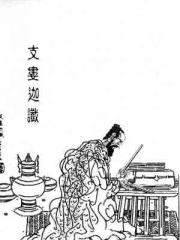
5. Lokaksema (147 - 200)
With an HPI of 61.42, Lokaksema is the 5th most famous Pakistani Religious Figure. His biography has been translated into 19 different languages.
Lokakṣema (लोकक्षेम, Chinese: 支婁迦讖; pinyin: Zhī Lóujiāchèn) (flourished 147–189) was a Kushan Buddhist monk who travelled to China during the Han dynasty and is one of the first known translators of Mahayana religious texts into any language.

6. Valerian Gracias (1900 - 1978)
With an HPI of 53.28, Valerian Gracias is the 6th most famous Pakistani Religious Figure. His biography has been translated into 16 different languages.
Valerian Gracias (23 October 1900 – 11 September 1978) was an Indian Catholic prelate who served as Archbishop of Bombay from 1950 until his death. He was made a cardinal in 1953 by Pope Pius XII.

7. Mirza Masroor Ahmad (b. 1950)
With an HPI of 52.23, Mirza Masroor Ahmad is the 7th most famous Pakistani Religious Figure. His biography has been translated into 17 different languages.
Mirza Masroor Ahmad (مرزا مسرور احمد; born 15 September 1950) is the current and fifth leader of the Ahmadiyya Muslim Community. His official title within the movement is Fifth Caliph of the Messiah (Arabic: خليفة المسيح الخامس, khalīfatul masīh al-khāmis). He was elected on 22 April 2003, three days after the death of his predecessor Mirza Tahir Ahmad. Following the death of the fourth caliph, the Electoral College, for the first time in the history of the community, convened outside the Indian subcontinent and in the city of London, after which Mirza Masroor Ahmad was elected as the fifth caliph of the Ahmadiyya Muslim Community. At the very commencement of his accession, he found himself forced into exile from Pakistan in response to pressure from the Government of Pakistan. Since being elected, he has travelled extensively across the world to meet the members of the community and address their annual gatherings. In many of the countries he has visited it has been the first visit by an Ahmadiyya caliph.

8. Khadim Hussain Rizvi (1966 - 2020)
With an HPI of 40.53, Khadim Hussain Rizvi is the 8th most famous Pakistani Religious Figure. His biography has been translated into 16 different languages.
Khadim Hussain Rizvi (Urdu: خادم حسین رضوی; 22 May 1966 – 19 November 2020) was a Pakistani Islamic scholar and the founder and Amir of Tehreek-e-Labbaik Pakistan, a religiopolitical organization founded in 2015, known to protest against any change to Pakistan's blasphemy law. Fluent in Urdu, Punjabi, Arabic and Persian, he was known for his speeches in the defense of the Islamic prophet, Muhammad, and apart from the Quran and hadith, for heavily quoting the poetry of Ahmad Raza Khan and Muhammad Iqbal, whom he considered to be his main influences.
People
Pantheon has 8 people classified as Pakistani religious figures born between 147 and 1966. Of these 8, 2 (25.00%) of them are still alive today. The most famous living Pakistani religious figures include Hafiz Saeed, and Mirza Masroor Ahmad. The most famous deceased Pakistani religious figures include Guru Nanak, Fariduddin Ganjshakar, and Naropa. As of April 2024, 1 new Pakistani religious figures have been added to Pantheon including Khadim Hussain Rizvi.
Living Pakistani Religious Figures
Go to all RankingsDeceased Pakistani Religious Figures
Go to all RankingsGuru Nanak
1469 - 1539
HPI: 85.46
Fariduddin Ganjshakar
1178 - 1265
HPI: 68.11
Naropa
1016 - 1100
HPI: 63.09
Lokaksema
147 - 200
HPI: 61.42
Valerian Gracias
1900 - 1978
HPI: 53.28
Khadim Hussain Rizvi
1966 - 2020
HPI: 40.53

